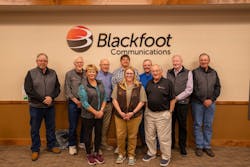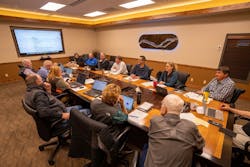Executive Insights With Jason Williams, CEO, Blackfoot Communications
From the moment I soaked in Jason’s responses to our questions, I wanted to invite him to dinner. He’s as open as a CEO gets. He shares what he doesn’t know and admits that Blackfoot needs to catch up on some important things like fiber-to-the-premises (FTTP) deployments and network automation.
Perhaps it's because he’s grateful that Blackfoot’s board took a chance on him eight years ago when they welcomed a literature student turned lawyer into the C-Suite. Perhaps it’s because he lives in Western Montana—a beautiful but challenging place to deliver high-speed broadband to the underserved.
Whatever it is, we’ll ask other leaders to have what Jason’s having. Read on to learn what we see in Jason and why you might also want to ask him over for dinner.
More specifically for operations, our AI approach is continuous learning and adaptation, focusing on network automation tools/software and improved data collection/analysis. Network security is a pillar underlying all efforts toward improving network operations and utilizing AI.
Happy 70th to Blackfoot Communications!
Blackfoot Communications serves more than 30 rural communities throughout its nearly 9,000-square-mile service territory in Western Montana and Eastern Idaho. The company celebrated the cooperative’s 70th year in business at its annual meeting in April. In addition to being one of the largest rural broadband providers in Montana and Idaho, Blackfoot also provides advanced networking and connectivity solutions to enterprise-level customers throughout the Rocky Mountain West.
As part of a multiple-year fiber build, Blackfoot connected nearly 1,800 locations to FTTP-based broadband in 2023 and plans to cut over more than 1,000 more locations to fiber-based broadband in 2024. Since 2017, Blackfoot has had 35% of its rural customers converted to FTTP.
ISE: Share two network-related learnings your team collected during the early days of this build that have been game changers in improving your deployments moving forward.
Jason Williams: First, we should have started years before we did. We were relatively late to the FTTP game as we were focused on aggressively building out our CLEC business over the last decade. With portions of our copper network approaching 50 years old, we spend huge amounts in OpEx to keep our DSL network up and running. It’s no secret that FTTP is much more efficient for broadband than copper. We’re seeing that in the areas we’ve already built out.
Second, plan to build more than you can at any one time. Early on, we ran into permitting problems for a few of our service areas. Since we had completed outside plant engineering for other areas, we were able to pivot quickly so as not to miss out on Montana and Idaho’s short construction season.
Topic: Rural Broadband
ISE: What’s your greatest joy and challenge related to ensuring your community’s residents can live a big life in a small community?
Williams: I’m biased, but I live in the most beautiful place in the world—Western Montana. The beauty can be deceiving, though, because making a living out here can be challenging. Whether it’s hundreds of inches of snow in the winter or devastating wildfires in the summer, nature is in the driver’s seat, making it challenging to deliver service in some of our areas. But our board is committed to getting FTTP-based broadband to as many rural customers as possible, ensuring that those living, working and going to school in our rural communities have access to the world.
Topic: Telecom Network Evolution
ISE: McKinsey's report1 shared, “Organizations have more than ever to gain from technological advances—and more to lose from falling behind.” This resonates equally with telecom companies as it does with customers. How does Blackfoot Communications plan to move toward intelligent networks and AI in network operations?
Williams: We have a company-wide initiative to give all our employees some baseline level of AI training. We’re also set to deploy AI across some applications many of our employees use every day to get them familiar with these tools and experience how they can help.
Finding ways to automate our network has been and will continue to be a priority. We must find ways to automate and streamline as we grow our customer base.
More specifically for operations, our approach is continuous learning and adaptation, focusing on network automation tools/software and improved data collection/analysis. Network security is a pillar underlying all efforts toward improving network operations and utilizing AI. We are evaluating a new network monitoring platform and event manager so we have more predictive intelligence around potential issues and can get to root causes faster than we do today.
Topic: FWA and FTTP
ISE: Share your perspective about the interplay between these two technologies when working to deliver gigabit speeds to serve hard-to-reach customers.
Williams: We own and operate a FWA network using both licensed and unlicensed spectrum. While FWA has a lower cost of entry into a market, you need to keep a close eye on the ongoing OpEx of those networks. Few subscribers are out here, so you have limited revenue growth but ongoing tower rents and labor increases. In addition, radios need to be replaced every 5 to 10 years.
That said, there are some locations where FTTP costs simply too much to justify the build. Our goal is to work with both established and emerging RF vendors to continue to find the most reliable, highest-speed, and lowest-cost FWA solution for those areas where fiber is too expensive.
Topic: Telecom Trends
ISE: How do you see emerging technologies such as 5G, IoT, and edge computing shaping the telecom landscape across rural America in the coming years?
Williams: For better or worse, sparsely populated states like Montana have a long way to go before emerging technologies become common. About 35% of our residential subscribers still purchase POTS services from us because they have no reliable mobile wireless offering. As Montana’s Senator Tester says, “Some of us out here don’t even have 3G, let alone 5G.”
Regardless, Blackfoot is well-poised to facilitate the deployment of these technologies with its extensive fiber network, which is growing daily.
Topic: Permitting and Easements
ISE: There’s been much debate in DC about permitting and other approval processes that can result in significant deployment delays and cost increases. What would help solve these challenges?
Williams: We ran into permitting problems early in our FTTP deployment and continue to run into permitting issues today. On the federal side, we have supported the idea of a “shot clock,” meaning, for example, that if we submit a complete permit application to a federal agency, the permit will be deemed granted within 45 or 60 days if that agency doesn’t act on it. Another option would be to require a streamlined permitting process for areas that have already been disturbed—i.e., areas where we have an existing network and we’re just reinforcing what we already have.
Railroad crossing permits are also an ongoing issue. A few years ago, we had modest success negotiating with the Montana-based division of a larger national railroad to establish some processes and timeframes. That helped a little, but it was voluntary, and whenever there are personnel changes at the railroads, it seems like we start over again.
Topic: Operational Realities
ISE: ICT industry analysts and observers often focus on CapEx budgets. But the reality is that OpEx can make or break the bottom line. The key to controlling OpEx is cost-efficiently improving network life cycle management for complex fiber and legacy networks. How is Blackfoot Communications reducing its OpEx?
Williams: Our strategy is implementing tools and processes that enable our employees to do more. We’re also using better network monitoring and management systems to be more proactive when dealing with issues in the field, like bad fibers or splices, failing optics, network interfaces and capacity planning. Getting ahead of these issues will allow us to reduce the number of reactionary responses we have, which often come with higher costs due to timing and urgency.
One initiative we currently have underway is a partnership with FNT Software to deploy their FNT Command/GeoMaps applications across the network. The platform supports easy-to-read DLRs and circuit records, providing physical and logical circuit tracking, primary and alternate circuit paths, and traceroute capabilities. These features, combined with site-specific information such as address details, notes, and photos, will significantly improve network management efficiency and data accuracy, both in the field and in the network operations center.
Topic: Edge Compute
ISE: The growing demand for low-latency applications, data-intensive services, and real-time analytics will drive the deployment of edge computing infrastructure. Talk about the network changes required for this.
Williams: As we design our network, we always identify critical routes (not just for us but for third parties too) and install additional ducts. In the future, we can use that additional duct for additional capacity or different types of fiber that may emerge for lower latency or increased lit speeds. We’re also looking at more ways to connect Montana and Idaho to larger metro areas in the Western United States. This will enable high-speed access between the larger data centers down to the smaller edge systems delivering finished services to customers.
Topic: Network Security
ISE: Talk about your network security strategy with Fortinet. Can a vendor partner in this critical area care about your network equally as much as you do? What are the concrete ways you will ensure it does?
Williams: Innovation is vital in partnering with vendors on network security. Fortinet's approach to a security fabric enabling automated protection, detection, and response along with consolidated visibility across both Fortinet solutions is key to understanding accountability when it comes to keeping the Blackfoot network safe and our customers' networks. We have worked with many network and security vendors over the last 15 years. Even though Blackfoot is a smaller ISP, Fortinet has been more interactive and involved with us than any other vendor. They ask for our feedback and transparently communicate what’s happening with their products. This has made for a very good partnership.
Topic: Legacy Systems and Interoperability
ISE: Talk about the ongoing challenge BSPs face in making legacy systems interoperable with newer, more effective solutions. What can be done to help them with this?
Williams: We’ve been updating our systems and processes for more than a decade. While we’ve had some success, we still have a long way to go. Fundamentally, legacy systems integration and interoperability boils down to corporate culture. Blackfoot spent the first 50 years of its existence as a heavily regulated telephone company. Now, we are a largely unregulated broadband provider, but that legacy mindset can still be the “tail wagging the dog.”
This business is not that complicated, and we are our own worst enemies for overcomplicating things. Lately, we’ve been looking at and using some low-cost, off-the-shelf applications that did not germinate within the telecom industry. They are super simple to use and are highly effective. I see us continuing to move more in that direction.
Topic: 5G
ISE: Share Blackfoot’s role in deploying fiber for 5G.
Williams: We work closely with all the national mobile wireless providers, providing fiber backhaul to hundreds of tower locations across Montana, Wyoming and Idaho. Because of our vast, empty spaces and sparse population, we must get creative when it comes to latency and redundancy. Blackfoot’s network engineers, who I would put up against the best in the industry, have developed some pretty creative solutions to ensure our infrastructure can support 5G deployments.
Topic: Corporate Culture
ISE: As a cooperative, Blackfoot is deeply committed to the communities it serves. You show this commitment by providing high-quality broadband and contributing to many community organizations and events, non-profit activities, and education. What are some of the projects Blackfoot is most proud of?
Williams: Pearl Jam’s bassist, Jeff Ament, lives in Missoula. He runs a non-profit that builds skate parks in small, rural towns across Montana. Blackfoot has contributed to several of these projects across our cooperative service territory. Whenever I drive by one of these parks, it is packed with kids. They’ve become a central place for social interactions in many of our rural communities.
Beyond that, we have a high employee engagement in volunteer work—up to 40% of our employees routinely participate in our Ambassador Program. These folks drive Blackfoot trucks in parades and celebrations, show up at county fairs and rodeos, and volunteer for community beautification days and projects. Our employees genuinely want to make these communities better places to live.
Topic: Paying It Forward
ISE: Share three things you recommend to other leaders who want to follow your path.
Williams: First, trust your subject matter experts but with a dose of healthy skepticism.
Second, this industry requires you to take the long-term view. While there needs to be short-term results, you should always maintain sight of your longer-term vision.
Third, if it’s important, say it more than once. I joke with my employees sometimes that they think I may be going senile because I keep saying the same things over and over. But if it’s important to me and the organization, I’d rather them hear it more than once than not at all or listen to it but forget about it.
Topic: Risks
ISE: What’s the most significant professional risk you’ve taken?
Williams: Accepting the job as CEO of Blackfoot. I studied literature in college and went to law school. I have no formal technical or business training. My board took a chance on me, and now, eight years later, I’m humbled to continue to lead such an amazing organization.
Topic: The Secret Sauce
ISE: What’s an essential personality trait someone needs to succeed in a company like Blackfoot Communications?
Williams: Be someone who never settles for just “good enough.” This industry is changing, customer expectations are changing, and cost/revenue assumptions are changing. We want employees and leaders who are always looking to improve, even if something is working just fine.
Topic: Dissent
ISE: What is one thing almost everyone disagrees with you about?
Williams: That the Seattle Mariners are the greatest team in MLB history!
REFERENCE
1. McKinsey, https://www.mckinsey.com/featured-insights/2023-year-in-review?cid=other-eml-alt-mip-mck&hlkid=14eff70c261f4f9789091ca1b07c385b&hctky=12322243&hdpid=6ff46fa4-eb3b-4d6d-bbbd-b847a5dd3f02#outcompeting-with-technology
Jason B. Williams is CEO of Blackfoot Communications, a regional broadband and technology solutions provider headquartered in Missoula, Montana. As a cooperative, Blackfoot is deeply committed to the communities it serves. Mr. Williams reports to a nine-member, cooperative Board of Trustees that represent more than 15,000 members/owners located in rural western Montana. To learn more, visit www.blackfoot.com. Follow them on LinkedIn, Facebook, and X @GoBlackfoot.
About the Author
Sharon Vollman
Content Ambassador for ISE EXPO
Sharon Vollman is the Content Ambassador for ISE EXPO. She is passionate about collaborating with thought leaders, SMEs and hard-working doers who design, plan and deploy ultra-reliable broadband networks. Vollman is committed to creating a variety of educational offerings for ISE EXPO attendees that inspire them to connect every U.S. citizen with the broadband networks we all want for our children and grandchildren.
Vollman has created educational partnerships with Broadband Service Providers including AT&T, Verizon, Lumen, Frontier Communications and others. She has covered the telecom industry since 1996.






